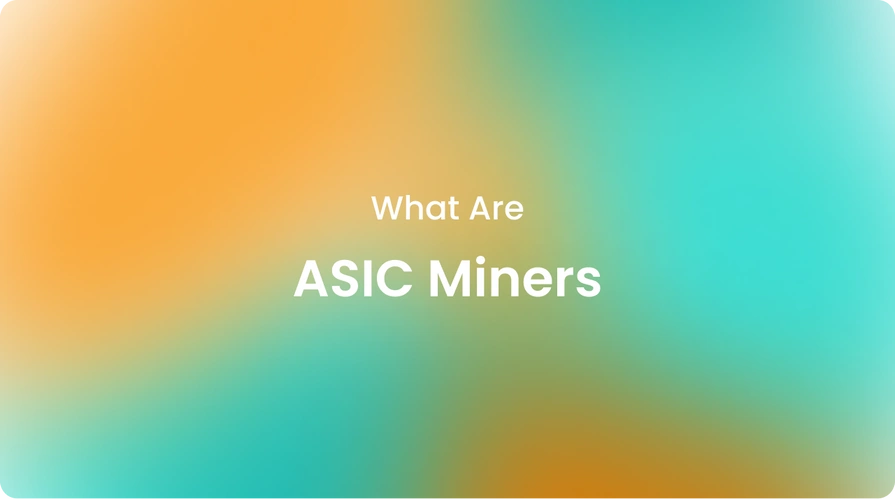With cryptocurrencies rapidly growing in popularity and value, more people are exploring crypto mining as a way to acquire digital coins and become ASIC miners.
Of the various crypto mining hardware options available, application-specific integrated circuits, or ASIC miners, have emerged as a popular choice due to their higher efficiency and hash rates.
This guide will provide an overview of ASIC miners, how they work, their advantages and disadvantages, profitability, the top coins to mine, and more. By the end, you'll have a solid understanding of this specialized crypto mining technology. Let’s start!
What is an ASIC?
In very basic terms, an ASIC is an integrated circuit (microchip) customized for a particular use rather than a general-purpose chip like a CPU or GPU. Logic gate circuits are programmed to perform mining tasks much faster than general components.
Thousands or millions of these logic gates in an ASIC miner provide immense computing power dedicated solely to crypto mining.
For example, a top-of-the-line ASIC miner can have a hash rate potentially thousands of times greater than even the most powerful GPU.
Is ASIC good for mining?
For the most part, yes. ASIC miners are excellent for crypto mining due to their superior hash rates and power efficiency compared to general hardware. To learn more about hash rates, make sure to check out “Crypto Hash Rate” and “Bitcoin’s Hash Rate.”.
They've become the most widespread mining rigs used by large crypto farms. ASICs have several key advantages, including higher profitability due to low power costs per GH/TH, as well as the ability to mine crypto coins like Bitcoin that are no longer viable with CPUs or GPUs.
The development of the ASIC miner
The first commercially available ASIC miners, like the 50 GH/s Avalon, hit the market in early 2013, drastically outpacing CPU and GPU mining. Subsequent generations saw exponential performance boosts; the Antminer S9 from 2014 delivered 14 TH/s, while contemporary top models exceed 2 GH/s.
China dominates ASIC production, with Bitmain, MicroBT, and others continually innovating. Today's most advanced machines are several orders of magnitude quicker than early ASICs and use cutting-edge 7nm processors.
How does ASIC mining work?
In simple terms, ASIC miners utilize their specialized integrated circuits to perform cryptographic hash functions (algorithms) on blockchain transaction data.
Whenever a miner finds a correct hash solution, it broadcasts the result to the network. If validated by other blockchain nodes, the miner receives a cryptocurrency reward along with any transaction fees.
The ASIC chips rapidly test millions of candidate hashes per second, seeking the needed solution much faster than general components can. Popular one-stop-shop crypto service provider platforms like Cryptobunq can help manage mining operations and payouts with node-as-a-service solutions.

ASIC miner advantages and disadvantages
ASIC mining offers advantages such as high hash rates, more cost-effective power consumption compared to GPU/CPU configurations, and the capability to mine cryptocurrencies in scenarios where standard hardware falls short.
On the downside, ASICs have no versatility—one model can only mine a single coin—and they become obsolete quickly as newer, more powerful models launch frequently.
Is ASIC mining worth it?
For large-scale, professional crypto mining, ASICs are absolutely worth it due to the immense hash power they provide. You can recoup the upfront costs within a reasonable window.
However, for small-time or hobbyist miners, the rapidly changing nature of ASIC technology and the need for constant upgrades may not make them as appealing as less powerful but more flexible GPU setups.
Diligent research, judicious planning, and selecting reliable blockchain service partners like Cryptobunq can help both casual and dedicated miners navigate the rapidly changing crypto mining landscape profitably.
Cryptobunq also offers other crypto and blockchain services, such as a crypto exchange API, crypto checkout and invoicing, crypto batch payments, custody and wallet, and more. You can trust CBQ for expert crypto solutions. Make sure to check out our case studies to learn more!
What is the best ASIC miner?
The “best ASIC miner” depends on one's budget, goals, and the coins being targeted. Generally speaking, the top models from Bitmain and MicroBT currently offer the highest overall performance per watt efficiencies.
In terms of straight hashing power, Bitmain's Antminer S19 XP Hydroid leads the pack, delivering 254 TH/s for Bitcoin mining. The WhatsMiner M70 and M71 from MicroBT are also very fast and power-efficient.
What is the lifespan of an ASIC miner?
On average, most ASIC miners remain relevant for 1–2 years before becoming obsolete or unprofitable to operate due to increased mining difficulty and newer, more powerful devices entering the market.
Top-shelf models may outlast others by staying relevant for 18–24 months before their performance significantly declines. Proper cooling and maintenance can extend an ASIC's usable lifespan.
What is the purpose of using ASIC in Bitcoin mining?
The primary reason for employing ASIC miners to solve the Bitcoin mining algorithm is sheer computational efficiency. Being able to achieve massive hash rates in the tera- and peta-hashes per second, ASIC chips far outperform general CPUs and GPUs, which topped out in the megahashes.
This focused efficiency is key to remaining competitive in Bitcoin's proof-of-work security model, which requires continuous upgrading of crypto mining power to maintain rewards.

How to mine crypto using an ASIC miner?
Here are the basic steps to begin ASIC crypto mining:
- Research the best ASIC model optimized for your preferred coin, like Bitcoin. It is better to research the best options.
- Purchase your ASIC from a reputable retailer and receive your unit safely.
- Set up the ASIC in a well-ventilated location with adequate power.
- Download mining software, such as CGMiner, or install preloaded firmware.
How much Bitcoin can an ASIC miner mine?
This varies greatly depending on the specific ASIC model, its hash rate, current network difficulty, electricity costs, and more.
A basic entry-level machine might average $5–10 worth of BTC monthly, while a high-end industrial rig could rake in several hundred dollars or more daily at today's valuations and difficulty levels.
Is ASIC or GPU mining better?
Both ASIC and GPU have merits, depending on one's needs. Nothing beats the sheer hashing power and scale efficiency of ASICs like Bitmain's Antminers.
But GPU rigs offer much greater flexibility to mine various algorithms and coins without hardware swaps. They also hold resale value better than outdated ASICs.
For small-time or casual crypto miners, the upfront costs and volatility of ASIC models make GPU mining a more sensible entry point into cryptocurrency extraction overall.
Is GPU mining more profitable than ASIC?
In terms of raw income generation at scale, ASIC miners have a clear-cut advantage over GPU rigs due to their substantially higher hash rates.
However, volatility across the Bitcoin mining industry means neither approach guarantees consistent long-term returns; careful assessment of network difficulty, coins, costs, and reliable price projections is paramount.
For lower budgets and more diversified portfolios across multiple coins, GPU mining may provide better stable profits owing to its versatility.
The bottom line
ASIC miners represent today's cutting-edge crypto mining technology. Their specialized design maximizes efficiency for proofs of work, driving the decentralization of networks like Bitcoin. While high costs remain, the advantage over other hardware grows wider each generation.
Cryptobunq's broader crypto solutions enable innovative use cases by providing the security and efficiency required for real-world adoption.
You can trust CBQ for your various crypto and blockchain services. If you want to learn more about our services and how they benefit your projects, contact us today!














